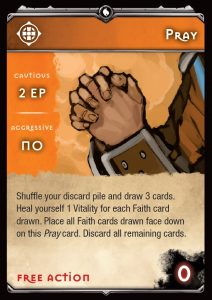
21 May Dawn of Heroes Design Spotlight: The Acolyte
 Dawn of Heroes is still deep in playtesting, but we have been making excellent progress. Although many things may yet change, I wanted to share some of our specific thoughts about individual heroes. As I indicated in the movement article, my goal is to clarify, differentiate, and balance the elements of Myth. I do not want to change how they feel to play, except to make them feel MORE like that.
Dawn of Heroes is still deep in playtesting, but we have been making excellent progress. Although many things may yet change, I wanted to share some of our specific thoughts about individual heroes. As I indicated in the movement article, my goal is to clarify, differentiate, and balance the elements of Myth. I do not want to change how they feel to play, except to make them feel MORE like that.
Many years ago, a friend of mine taught me a definition of “broken” in terms of gaming that has stuck with me. He said that a game element or strategy is broken if a player feels they must either always include it or assume that someone else will. This is certainly true in competitive games, but it can be true in cooperative games (and RPGs) as well.
An example of this in Classic Myth is how drastically the game changes based on the presence or absence of the Acolyte. Healing is strong in any game that has it, but usually there is a tradeoff – bringing a healer means you are taking things more slowly and cautiously. You sacrifice speed for safety, and that becomes a strategic decision. This was not always the case in Classic Myth, where the Acolyte was able to heal so drastically that the other heroes actually accelerated.
The Cost of Healing
In the same way that bringing the Acolyte should be a choice rather than a requirement, the Acolyte’s own healing should always be a tradeoff. The classic version of the Acolyte’s healing typically generated threat, but we wanted to make the cost much more direct. Here is one of the bread-and-butter healing cards of the Acolyte, comparing its 2.0 version to the current beta version of Dawn of Heroes:
Healing (along with some powerful attacks) now has a much more direct and personal cost for the Acolyte. Losing Vitality may seem extreme, but it is now part of the rhythm of playing the Acolyte. He now has cards specifically geared towards healing himself, as you can see in the new secondary effect of Pray:
The Acolyte in Dawn of Heroes will need to change stances regularly from round to round, because most attack and healing cards favor the Aggressive stance, while most self-restoring cards favor Cautious. We want this rhythm to flow naturally from the cards, but we also want it to be something that players can practice and improve. We don’t want playing the healer to be boring – we want it to be accessible enough for new players yet challenging enough to engage experienced players.







